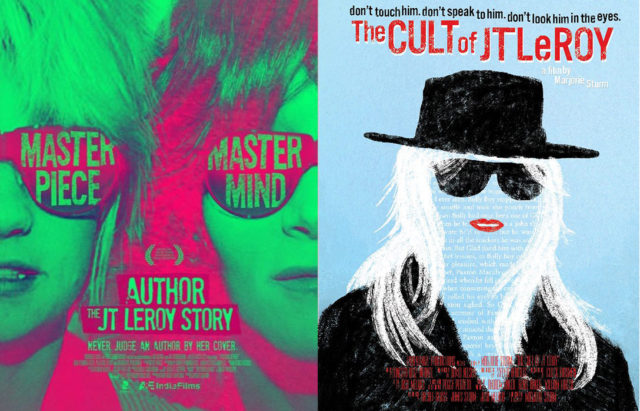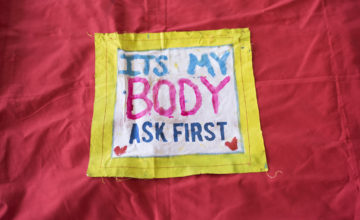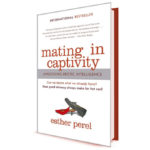
Laura Albert is pretending to be someone she’s not. Again. Or maybe she’s telling the truth this time. That’s the problem when someone lies so much to so many people: when should we start believing their stories about wolves?
You probably know Albert better as JT LeRoy, the abused, abandoned, HIV-positive, gender-bending, teenaged, trick-turning, literary phenom who, around the turn of the century, penned disturbing, supposedly semi-autobiographical stories of masochistic sex. After publishing three books (one of which became a movie), amassing a cult-like following of duped celebrities, and convincing her boyfriend’s younger half-sister to embody this character in public, Albert’s ruse was finally exposed by New York magazine in 2006.
Now, Albert’s telling her behind-the-scenes story in the new documentary, Author: The JT LeRoy Story, directed by Jeff Feuerzeig. Breaking the fourth wall in a punk rock ensemble that only her hometown of San Francisco could forgive, Albert narrates how and why the JT phenomenon snowballed, with excerpts from recorded literary events, moody dramatizations of hand-written manuscripts being forebodingly faxed, third person interviews with agents and mentors, old home videos given the arty-filter treatment, countless recordings of phone calls and voicemail messages on cassette tapes (which apparently a few celebrities are not happy about), and animated doodles illustrating furious lined-paper scrawlings about despair and overdubbed with the singularly sleepy, southern JT drawl.
The end of the film reveals the origin of JT LeRoy, the traumatic catalyst that sent the young Albert running, screaming, into dream worlds: her sexual abuse as a child by a family friend. The fallout is brutal. The sexualized spankings cross her pain and pleasure wires. She’s institutionalized as a teenager. A life-time struggle with overeating (“because he liked me better thin”) results in pre-diabetic gastric bypass surgery. And she becomes obsessively compelled to create characters — in her mind, on the page, and, most destructively, in real life.
According to Albert, the creation of JT was not a malicious hoax, but a coping mechanism to deal with her demons. Rather than one of several multiple personalities, the pretty blonde broken boy was an essential part of herself that required artistic expression. The only way she could be free was by being someone else.
Intensely personal and revealing, Author is a tragic tale of sorrow and the quest for salvation. And if much of the media attention in the few weeks since its premiere is any indication, everyone’s falling for it. Again.
Laura Albert is, undeniably, a complex, creative genius with a disturbing past. But Author trades in the same master manipulation that enabled Albert to get JT to the Cannes Fucking Film Festival: the sob story ruthlessly wielded to get the responses she craves. And Albert is good.
I myself fell for it. As a young editor at Nerve.com, the sex and literary darling of late-90s digital media, I spent hours on the phone talking with Laura as JT, editing “his” stories for our website and short-lived print magazine, typing for “him” during live chats, even interviewing “him” and actor Mike Pitt in a truly bizarre conference call that felt like engaging two stoned high school kids rather than acclaimed, indie up-and-comers. “He” sent me one of his famous raccoon penis bones and I even made the acknowledgements of the first edition of the first JT book, Sarah (along without roughly 150,000 others). A few years later, when Savannah Knoop was posing publicly as JT — such meteoric stardom had ultimately demanded an avatar — I went to a book signing to finally put a face to the voice. Walking away from the author’s table, I turned to my friend and said, “That’s not the person I talked to on the phone.”
When the last veil finally dropped, I didn’t feel like a victim. For me, this was an interesting part of an interesting job that resulted in some interesting pieces that were perfect for Nerve’s brand of literate smut. A few years ago, I reminisced with my fellow editor there, Jack Murnighan, who’d been JT’s initial contact at the magazine (back then “JT” went by “Terminator”). He too wasn’t upset about the fraud: “I think it was brilliant and I’m impressed she was able to pull it off.” He defended her, saying, “Art is about forcing you to pay attention to something that you otherwise would have missed.”
There was also something admittedly amusing about what fools she’d made of renowned, intellectual artists and actors. The first sixty seconds of Author has Wynona Ryder absolutely gushing over JT to a packed house like a love-struck school girl. At some of the earlier literary events in New York with celebrity guest readers, before public JT appearances were a part of the scene, I was always struck by how many people in attendance competed with each other to see who could claim the deepest connection with the mysterious starlet, as if the intimacy Albert concocted with them somehow granted them more social currency. At one event, actor Ben Foster (who appeared in the adaptation of the second novel, The Heart Is Deceitful Above All Things) said to the crowd, quite melodramatically, as if delivering lines in a play, “He’s one of those people that you want to live more truthfully after spending time with.” Irony is hilarious.
Everyone wanted to believe in JT. And many will want to believe in this iteration of Albert, too. Americans are suckers for a good redemption story: the hooker with the heart of gold…the murdering skinhead who makes a black friend…the abusive alcoholic now in recovery. To be sure, forgiveness can be a powerful and often necessary thing. But without truth and consequences, taboo-busting becomes the goal. The main question becomes, “How much can I get away with?”
And that appears to have been Albert’s main M.O. all along. But you won’t find any admissions to or apologies for that kind of social engineering in Author. For that, you’ve got to watch The Cult of JT LeRoy, the much quieter JT documentary — without backing from bigwigs like Author’s Magnolia Films and Vice — from two years earlier that, according to its director Marjorie Sturm, Albert tried to prevent the release of with imminent legal threat.
Cult outlines the real damage Albert did, seemingly without remorse. Via in-depth interviews and court depositions (Albert was sued for fraud by the film company that had optioned the rights to the first book), we learn of the pathological lying and exploitation that became Albert’s full time job, a way of life. She spent two years in telephoned therapy sessions every single day with Dr. Terrence Owens, a psychiatrist at a mental health facility for kids, using up precious hours he could have spent with real troubled teens. She’d keep confidants like writing mentor Dennis Cooper on the phone, sometimes on holidays or into the wee hours of the night, threatening suicide. She seduced another long-distance mentor, author Bruce Benderson, into taking on a very intimate, paternal role, only to turn around and accuse him of pedophilic tendencies. With another committed fan, a single father, she begged him for sado-masochistic phone sex lest JT kill himself; fearing for the troubled teen’s life, he acquiesced, only to feel sick to his stomach afterwards.
Watching The Cult of JT LeRoy made me much less forgiving. While it was never personal for me, it was for others, and their cumulative hurt is exactingly documented in Cult. The film confirms, over and over again, what I’d heard from one person soon after the exposé ran here in New York.
JT/Laura and I happened to have the same agent, Ira Silverberg, at the time, and after some gentle nudging for gory details of the affair, he shared some of his experience with me. It was shocking, but hearing these themes reiterated by one person after another in the film make Albert’s ploy that much more offensive. Silverberg described how Laura, posing as JT’s roommate and handler “Speedie” aka “Emily Frasier” complete with British accent, would rapaciously con places for upgrades and free swag during travels and appearances (a propensity for scamming confirmed by her ex-boyfriend). But what seemed to upset Ira most was how she unscrupulously curried favor with the gay community by initially playing up JT’s HIV-status (which JT later seemed mysteriously cured of). What he said over lunch, he reiterated in Sturm’s film:
The bottom line is, we all lost a lot of people to AIDS…a lot of friends, a lot of loved ones…so by the time she came around saying I’m a 15 year old with HIV, she got to a lot of people who had a lot of empathy, who really thought the voice of the young person suffering would be important to hear and get out in the world. She hit a lot of us below the belt.
Albert’s attorneys in the case argued that JT LeRoy was simply a pseudonym. But pseudonyms don’t cause that kind of pain.
And causing that kind of pain is not sane. Certainly mental illness can be a font of great literature: think Edgar Allen Poe, Virginia Woolf, Robert Lowell, Sylvia Plath, Anne Sexton, David Foster Wallace… As Aristotle said, “No great mind has ever existed without a touch of madness.” But how much leeway do we give the tortured artist? When does artistic license become simply sociopathy?
Some have said that the work should speak for itself — if you liked Sarah, a piece of fiction, when it was written by LeRoy, you should still like it when it was written by Albert. But art doesn’t exist in a vacuum. A museum-curator friend of mine once took me to an outsider art exhibit, and I was amazed and perplexed by some of the truly hideous works on display. That is, until my friend explained the fascinating biographies of some of these untrained artists that reflected historical issues of race, gender, war and politics, which immediately gave them more depth and meaning. Context matters. Most people wouldn’t hang a print of a lovely watercolor by Adolph Hitler in their dining room.
So, considering this particular body of work and the trauma it sprang from (even if it was a different trauma than we originally understood), do we forgive and forget? As an ADHD culture fed on 140-character Tweets, 6-second Vines and ghosting Snapchats, our shot, short-term memory would seem to favor forgetting. This collective fuzziness is what allows Chris Brown to brutally beat up Rihanna in 2009 and then win a Grammy less than three years later. One would have thought the revelation of a systematic cover-up of widespread sexual child abuse by Catholic Church authorities would have put a serious dent in flock membership, but the Vatican’s following is still 1.2 billion strong. And what about Donald Trump? Considering his avalanche of outrageous gaffes and disqualifying mistakes that his candidacy appears concretely impervious to, it’s as if he’s got his very own secret neuralyzer, a la Men in Black. And now here comes Laura Albert, movie star, back to sell you some real estate in the wilds of Appalachia with a film that’s heavy on celebrity glam, light on accountability.
Both documentaries are equally compelling and pretty similar stylistically. Yet as of this writing, the just-weeks old Author has a rating of 80% from 65 counted critic reviews on RottenTomatoes.com; the 2-year-old Cult has no critic rating, zero counted professional reviews. I fear Laura is getting to control the narrative all over again.
Rewarding a troubled artist — a liar and, some would say, a criminal — simply to satisfy our morbid curiosity seems like the lazy, apathetic choice. But perhaps we could resist our urge to divide the world into either sinners or saints — like JT (and I mean JT) poetically resisted doing in “his” writing — and find something redeemable in the rubble.
Then again, maybe there are better ways to be entertained and enlightened. For instance, if you really want to see Wynona Ryder emote, watch Stranger Things instead.
















